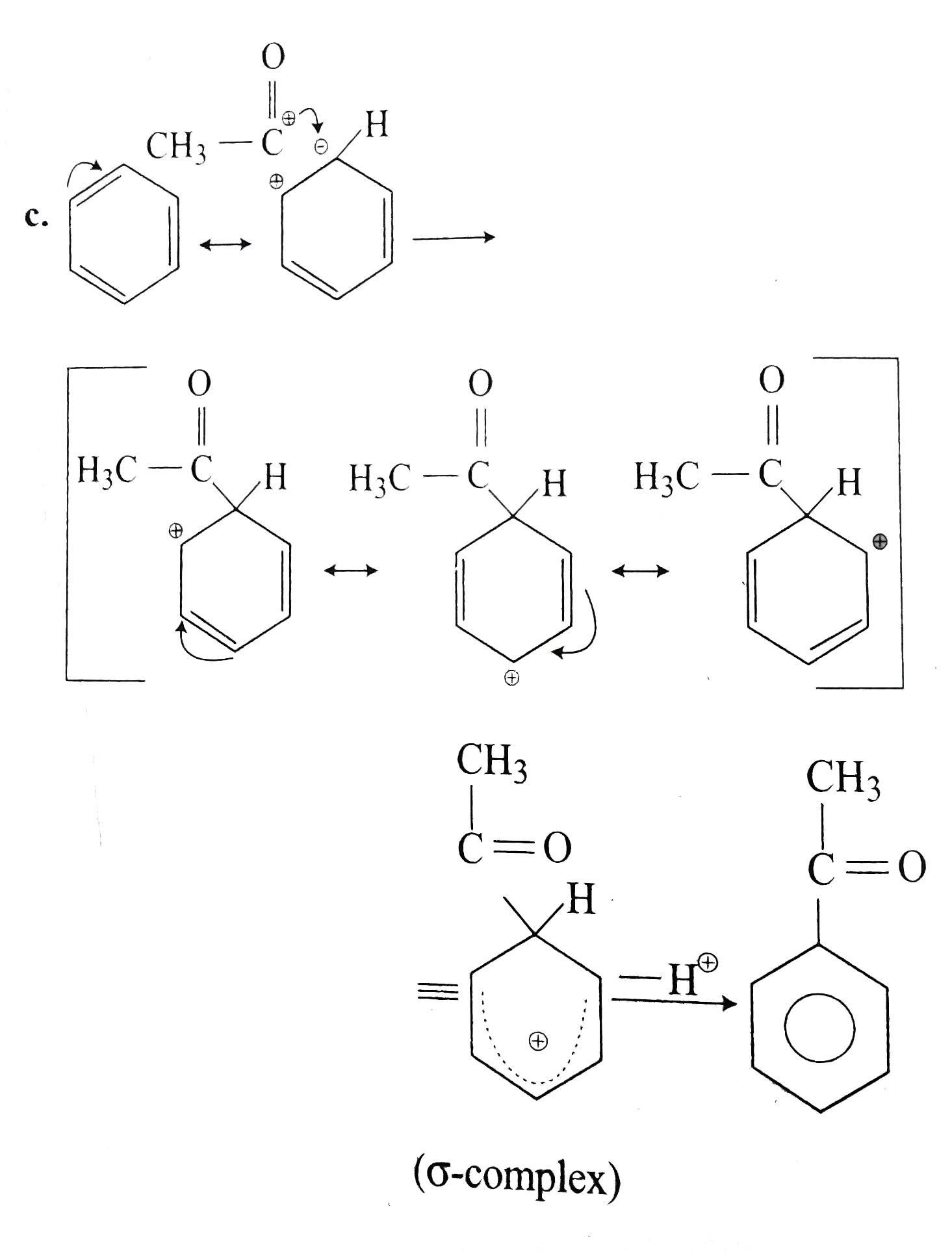Classify the reagents shown in bonds in the following equations as nucleophilies or electrophiles. Use curved-arrow notation to show the electron movement.
(a) CH3COOH+HOӨ→CH3COOӨ+H2O
(b) CH3COCH3+NCӨ→CH3C(CN)OHCH3
( c) C6H6+CH3⊕CO→C6H5COCH3.
 is a nucleophile having unshared electrons which can be donated or shared with E.
is a nucleophile having unshared electrons which can be donated or shared with E.
 . NCΘ is a nucleophile having unshared electrons.
. NCΘ is a nucleophile having unshared electrons.

(CH3−⊕C=O) is an electrophile and can accept ¯es.
Topper's Solved these Questions
- BOOK - CENGAGE CHEMISTRYCHAPTER - GENERAL ORGANIC CHEMISTRYEXERCISE - Comprehension20videos
GENERAL ORGANIC CHEMISTRY
- BOOK - CENGAGE CHEMISTRYCHAPTER - GENERAL ORGANIC CHEMISTRYEXERCISE - Multiple Correct22videos
GENERAL ORGANIC CHEMISTRY
- BOOK - CENGAGE CHEMISTRYCHAPTER - GENERAL ORGANIC CHEMISTRYEXERCISE - Subjective11videos
GENERAL ORGANIC CHEMISTRY
- BOOK - CENGAGE CHEMISTRYCHAPTER - CLASSIFICATION AND NOMENCLATURE OF ORGANIC COMPOUNDSEXERCISE - Analytical and Descriptive Type3videos
CLASSIFICATION AND NOMENCLATURE OF ORGANIC COMPOUNDS
- BOOK - CENGAGE CHEMISTRYCHAPTER - HYDROGEN, WATER AND HYDROGEN PEROXIDEEXERCISE - Subjective Archive (Subjective)3videos
HYDROGEN, WATER AND HYDROGEN PEROXIDE
Similar Questions
Identify the reagents shown in bold in the following equations as nucleophiles or electrophiles.
(a) CH3COOH+OH−→CH3COO−+H2O
(b) CH3COCH3+NC−→CH3C(CN)OHCH3
(c) C6H6+CH3+CO→C6H5COCH3View SolutionIdentify the reagents shown in bold in the following equations as nucleophiles or electrophiles.
(a) CH3COOH+OH−→CH3COO−+H2O
(b) CH3COCH3+NC−→CH3C(CN)OHCH3
(c) C6H6+CH3+CO→C6H5COCH3View Solution
Knowledge Check
- Question 1 - Select One
Rank the transition states that occur during the following reaction steps in order of increasing stability (least → stable)
1. H3C−+OH2→CH+3+H2O
2. (CH3)3C−+OH2→(CH3)3C++H2O
3. (CH3)2CH−+OH2→(CH3)2CH++H2OA1<2<3B2<3<1C1<3<2D2<1<3
Classify the reagents shown in bold in the following equations as nucleophiles or electrophiles.
(a) CH3COOH+OH−→CH2COO−+H2O
(b) CH3CH2Br+SH−→CH3CH2SH+Br
(c) C6H6+CH3CO→C6H5COCH3View SolutionClassify the reagents shown in bold in the following equations as nucleophiles or electrophiles :
(a) CH3COOH+HO−→CH3COO−+H2O
(b) CH3CH2Br+HS−→CH3CH2SH+Br−
(c ) C6H6+CH3CO+→C6H5COCH3
(d) CH3COCH3+CN−→CH3OH∣C∣CN−CH3View SolutionIdentify the reagents shown in bold in the following equations as nucleophiles or electrophiles:
(a) CH3COOH+HO−→CH3COO−+H2O
(b) CH3COCH3+−CN→(CH3)2C(CN)(OH)
(c ) C6H6+CH3+CO→C6H5COCH3View SolutionClassify the following in one of the reaction type studied.
(a) CH3CH2Br+HSӨ→CH3CH2SH+BrӨ
(b) (CH3)2C=CH2+HC1→(CH3)2C1C−CH3
( c) (CH3)3C−CH2OH+HBr→(CH3)2CBrCH2CH3
(d) CH3CH2Br+HOӨ→CH2=CH2.View SolutionDraw the resonance structures for the following compounds. Show the electron shift using curved-arrow notation.
(a) C6H5OH
(b) C6H5NO2
( c) C6H5⊕CH2
(d) CH3CH=CHCHO
( e) CH3CH=CH−⊕CH2
(f) C6H5CHO
(g) CH2=CHOCH3.View SolutionName the following compounds according to IUPAC system of nomenclature :
(a)CH3CH=CHCHO
(b)CH3CH(CH3)CH2CH2CHO
(c)OHCC6H4CHO−p
(d) CH3COCH2COCH3
(e)CH3CH2COCH(C2H5)CH2CH2ClView SolutionClassify the following reactions in one of the reaction type studied in this unit.
(a) CH3CH2Br+HS−→CH3CH2SH+Br−
(b) (CH3)2C=CH2+HCl→(CH3)2ClC−CH3
(c) CH3CH2Br+HO−→CH2=CH2+H2O+Br−
(d) (CH3)3C−CH2OH+HBr→(CH3)2CBrCH2CH2CH3+H2OView Solution

